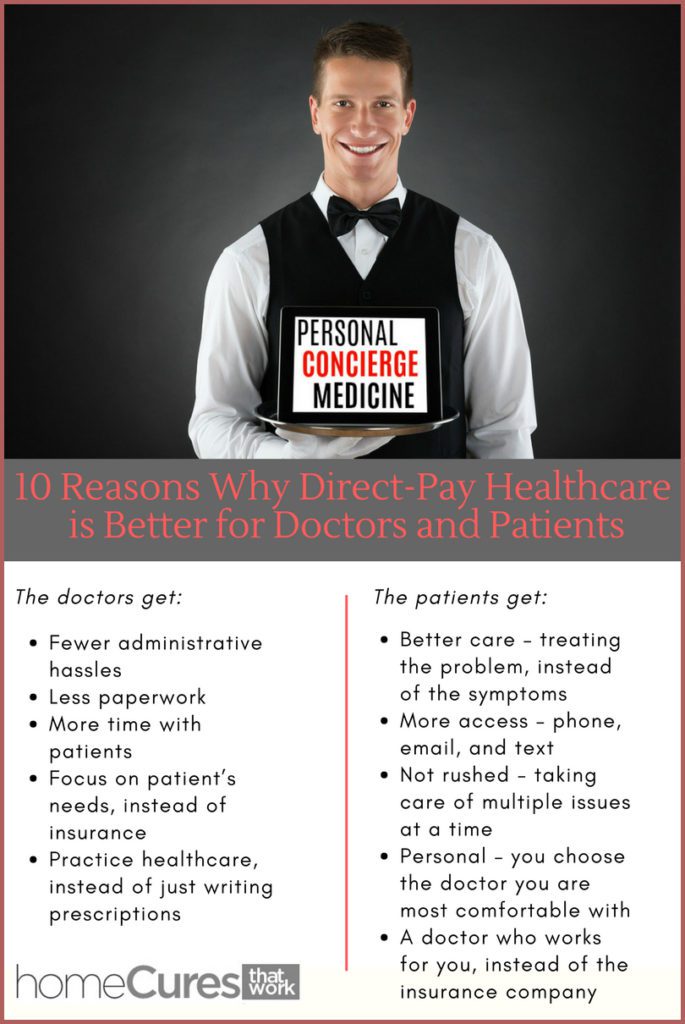Is Concierge Medicine the Way of the Future?
An Unconventional Approach to Fix What’s Broken in Modern Medicine
For hundreds of years people have paid for insurance to offset the catastrophic costs of unforeseen problems.
- We buy life insurance to cover the costs of an untimely death.
- We buy auto insurance to cover accidents.
- And we buy health insurance in case of illness.
These life events can be very costly and we cannot predict when they will happen. We do not know when we’ll die, get in an accident, or get sick. For these reasons, we buy insurance.
But health insurance has become a large problem. We’ve all read the headlines:
- A Major Insurer Just Pulled Out of Obamacare[1]
- Health Insurance Premiums Skyrocket[2]
- Uncertainty of Obamacare[3]
- Health insurance costs are skyrocketing[4]
As health insurance costs have increased and services have decreased, those with insurance are paying as much or more for healthcare as those without insurance.[5]
The Health Insurance Issue Nobody Talks About
Insurance Rules
Doctors who take insurance are often pressed for time because insurance pays them less.[6] Many doctor’s offices have a policy that allows a patient only one complaint or symptom per visit. This necessitates numerous visits and months or years to address multiple issues.
In some cases, doctors take this rule to the extreme:
“Bruce Angus says his wife Samantha, 60, died of a heart attack two weeks after she complained to a doctor about back pain in Selkirk, Manitoba. When she tried to speak of her heart problems, the doctor interrupted her and told her she’d have to make another appointment: ‘One appointment. One problem.’ That’s not good medicine.” [7]
Added Patient Expenses
Patients also have more expenses with insurance. While many receive government subsidies for health insurance, those who don’t find their healthcare expenses have increased dramatically. According to the Kaiser Foundation, whether we have insurance or not, we have about the same out-of-pocket expense for healthcare, about $3,000 per year. But those who are paying for insurance have the added expense of premiums, which can be considerable.[8]
It’s no wonder that so many doctors and patients are opting out of insurance for their regular care.
Why Physicians and Patients are Choosing Concierge Medicine
The word “concierge” elicits visions of fancy hotels and expensive restaurants. Indeed, concierge medical practices charge from $3000 to over $40,000 per year – and they bill insurance on top of that. But they offer services that you couldn’t get from a doctor who only takes insurance.
- Concierge practices include longer visits, home visits, and phone access.
- And if you need specialty care, then your concierge doctor might fly with you to the best place in the world for treatment.
- While Medicare doesn’t include an annual physical exam, concierge doctors often include an “executive physical” that includes tests.
Direct-Pay – A New Way Forward
Another option for affordable healthcare is direct-pay. Many doctors going to direct-pay models are able to care for people better. These doctors generally don’t take insurance so they aren’t under any constraints for time or paperwork. They are usually less expensive than doctors who accept insurance. In addition, some doctors who do take insurance will discount their prices for direct-pay patients.
The way the direct-pay model works is that the doctor charges a monthly fee that covers basic, primary care services. When a direct-pay patient comes to the doctor, there are no additional fees within the scope of their coverage.[9]
Direct-pay doctors often have phone services, and even basic laboratory and radiology included. Many offer email consultations, or even home visits. The focus is on extraordinary customer service with high value on the patient. It also improves care for patients who are NOT in the office.
The price for direct primary care could be anywhere from $50 to $200 per month, depending on the services provided and patient needs. A big advantage is that there is no deductible or co-pay for visits. Many patients actually spend less on their healthcare because co-pays and deductibles have risen sharply. Also, there is significant cost savings by switching to a high-deductible plan over a “no deductible” plan. This could easily offset the cost of the doctor. This way, you receive better care for less money.
Direct-Pay Provides Better Patience Care
While some direct-pay doctors practice standard medicine, most are moving to a functional model. Standard medicine has “a pill for every ill.” Standard medicine treats each symptom separately. But functional medicine seeks to find the root cause of symptoms. Once the cause is removed, all the symptoms go away, and the medications become unnecessary.
For example, there are over 25 different causes of “arthritis.” The standard medical practitioner would relieve the symptom with an anti-inflammatory drug taken for life. But the functional doctor would ask, “Why is there inflammation in your joints in the first place?” After discovering that it’s due to a toxin, nutrient deficiency, or metabolic problem, for example, the cause may be reversed, and the arthritis often goes away.
You can apply this functional model to most of the issues that afflict people. Functional medicine changes the conventional disease-centered focus of medical care to a more patient-centered approach that addresses the whole person instead of merely isolated symptoms.
The direct-pay model is often equated to ancient Chinese medicine:
“Another fundamental notion of Chinese Medicine is the prevention of disease and maintenance of health. Historically, a Chinese Medicine doctor was paid a retainer to keep their patients healthy. If a patient became sick, the doctor would not be paid until the patient’s health returned. In a similar vein, a doctor that resorted to surgery was considered an inferior doctor. If he/she did their job correctly and helped their clients stay healthy, there would be no need to perform surgery.”[10]
The insurance doctor gets paid by, and thus works for, insurance companies. But the direct-pay doctor gets paid by and works for you. If you aren’t getting the results you need, then you can move on and take your money somewhere else. Moreover, the incentive for the direct-pay doctor is to keep you well. The insurance doctor only gets paid for sick people, so it’s in their best interest to keep their patients sick.
Think about it: When does an insurance doctor get you off blood pressure medications? How long will you be taking that cholesterol medication? They have a client for life. On the other hand, the direct-pay doctor is most relieved of a burden when you no longer need any medications, when you’re well! It’s easier to care for a thousand well people, than a hundred sick people. Therefore, most direct-pay doctors use a functional medicine model – removing the cause instead of just treating symptoms.
Some direct-pay doctors work online, using media like Skype or Facetime, as well as email and text. Thus, a person can choose a doctor literally from anywhere in the world. People who can’t take off a half-day of work to go to the doctor or who don’t drive will find these options very convenient. The online doctors find they can handle a large majority of problems, and will be able to triage to help you determine if it’s necessary to go to urgent care or the ER. Many people just want to be able to contact someone they can trust who knows if they need urgent treatment. When chronic pain and other recurring health issues keep dragging you down, you’ll be glad to know there is someone who can lift you back up.
All things considered, a direct-pay model is better for both doctors and patients for many reasons.
The doctors get:
- Fewer administrative hassles
- Less paperwork
- More time with patients
- Focus on patient’s needs, instead of insurance
- Practice healthcare, instead of just writing prescriptions
The patients get:
- Better care – treating the problem, instead of the symptoms
- More access – phone, email, and text for simple questions are often included
- Not rushed — taking care of multiple issues at a time, instead of only one per visit
- Personal – you choose the doctor you are most comfortable with
- A doctor who works for you, instead of the insurance company
Is Direct-Pay Right for You?
Only you can say for sure, but the way to decide is only partly based on the financial benefits. Let’s look at some numbers as an example:
For my family, a standard Blue Shield policy cost is:[11]
- Bronze: $1475.00 per month premium ($75 visits and $12,600 deductible)
- Gold: $2169.00 per month premium($30 visits and no deductible)
- Platinum: $2789.00 per month premium ($15 visits and no deductible)
If we look at the annual cost:
- Bronze: $17,700 + $12,600 = $30,300 (total if we meet the deductible)
- Gold: $26,028
- Platinum: $33,468
Conventional full coverage insurance plans can be catastrophicly high! Even a no-deductible plan can be awefully expensive! But an “expensive” direct-pay doctor would be the financially advantageous option over getting a Gold or even Platinum health insurance plan.
Direct-Pay FAQ:
- Can the monthly payments to the doctor count towards the deductible? No.
- Can the monthly payments to the doctor be paid by an HSA or FSA? Yes.
The doctor can give a receipt that can be submitted to your insurance. It may then reimburse a portion of covered visits, which would then apply to your deductible.
However, the bigger issue is your health, because that’s why you have health insurance. The direct-pay doctors generally give much better service, allowing you to take care of health issues sooner. Moreover, if you chose a doctor that has knowledge and will teach true principles of health, helping you restore normal body functions, the value is immensely greater than the insurance that only covers drugs and surgery to treat symptoms. When it comes to your health, “an ounce of prevention” is worth way more than “a pound of cure!”
Are you tired of being rushed through your medical visits? Not having your complaints listened to? Never really feeling as good as you want to feel? Not getting answers to your medical problems? Then it’s time to take a closer look at direct-pay healthcare, where your health and well-being are the only focus.
Dr. Saunders is a practitioner of functional medicine, which seeks to find the root cause of symptoms. His Integrative Medicine VIP Program is the only concierge service in the country that specializes in functional medicine.
A growing number of people (like the elite rich) gladly pay $40,000 to upwards of $80,000 per year for this kind of service. And it’s worth every penny to them for the peace of mind it brings them, along with the front-of-the-line level of service.
But most people can’t afford to pay that much.
That is why Dr. Saunders created the VIP Concierge Doctor Program at a reduced rate. This program allows you quick and easy access to a licensed doctor but you can use your regular physician, as needed, through your normal processes. The ViP Program simply allows you to access a medical professional directly and quickly, which is usually not the case in most traditional medical plans.
Visit Dr. Saunders’ website here to find out more information and to get enrolled!



















